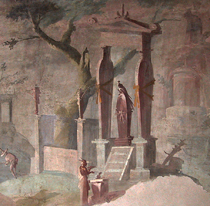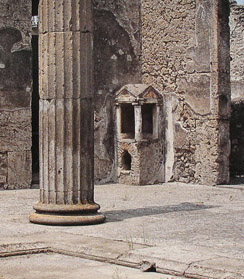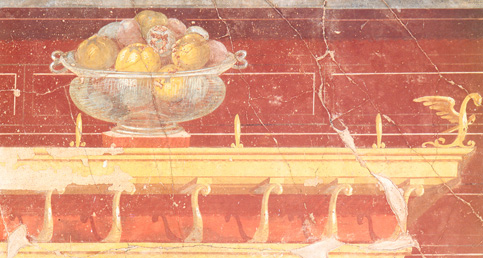 1>
1>The Roman Domus and In-House Worship: the Fetish Core to Roman Life
In order to fully understand the concept of the House as Sanctuary, it is first necessary to extract the wall-paintings from the dominant, overly rationalistic, view of Roman society that ignored their fetish core. The substantial achievements of this otherwise rational and disciplined society, often masks the fact that occult and superstitious practices governed much of what they did and thought. Sacrifice and divination were two of the most commonly practiced forms of religious expression and they significantly contributed to the political and social stability of the Roman Republic and the Empire that followed (fig.1). Hitherto, the possibility that Roman wall-painting functioned as a religio-fetish object has been largely ignored due to their domestic location. Had the paintings existed in Temples or Tombs this may not have been the case. Fetish, in this context, is used in a post-Freudian sense to mean something in which divine or supernatural powers are thought to reside. In this instance it was the fabric and décor of the Roman house that became a fetishised environment, which was both apotropaic (protective) and cathartic (concerned with healing and well being) (fig.2&3). The wall-paintings, like the religious practices they mirrored, blurred the boundaries between the natural and supernatural and in so doing created an environment that was reassuringly protective.
The numerous shrines found in domestic environments clearly indicate that religious practices took place within the house (fig.4). Thus, in addition to its commercial and domestic function the house was used as a space in which to perform ritual ceremonies associated with occupant belief and the worship of tutelary gods and spirits (fig.5). Practices such as these gave the house an almost quasi-anthropomorphic status. The house as a religious space, and even as a religious object in its own right, seems far less strange if we remind ourselves that Roman society was built upon a symbiotic relationship between secular and religious practices. The role of the house as a place of worship becomes clearer if we project the ancient Roman house forward in time to the early Christian era, when the domus become the domus ecclesiae (religious house), before eventually surfacing as the domus dei (god’s house) or church. Michael White, in his book Building God’s House in the Roman World, in addition to discussing the house as a site for pagan cult worship, also details some of the long held theories concerning the Roman atrium as a model for early New Testament churches. (White 1990:12-20, 31-47) With regard to in-house worship, White revealingly points out that it was not unusual for a cult to be made up of the members of a single household, which in some case could be well over a hundred, if one included dependants and slaves. [On the transition from pagan to Christian in-house forms of worship see Bowes, K., 2008, Private Worship, Public Values, and Religious Change in Late Antiquity.]
 4
4 3
3
|